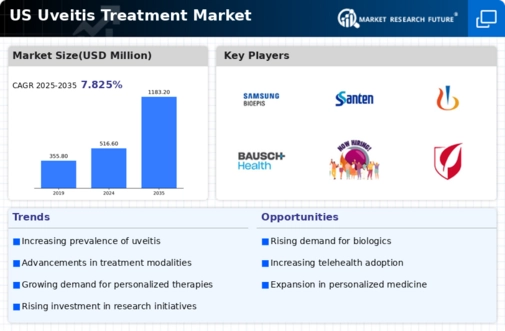Growing Incidence of Uveitis
The rising incidence of uveitis in the US is a critical driver for the uveitis treatment market. Recent studies indicate that uveitis affects approximately 38,000 individuals annually, with a notable increase in cases attributed to autoimmune diseases and infections. This growing patient population necessitates effective treatment options, thereby propelling market growth. The uveitis treatment market is responding to this trend by developing innovative therapies and expanding treatment protocols. As awareness of uveitis increases among healthcare providers, early diagnosis and intervention become more prevalent, further driving demand for treatment solutions. Consequently, the market is likely to witness a surge in the development of targeted therapies and biologics, aimed at addressing the specific needs of this expanding patient demographic.
Rising Healthcare Expenditure
Rising healthcare expenditure in the US is a significant driver for the uveitis treatment market. As healthcare spending continues to increase, patients are more likely to seek treatment for uveitis and related conditions. In 2025, total healthcare expenditure in the US is projected to reach $4 trillion, indicating a growing willingness to invest in health services. This trend is particularly relevant for the uveitis treatment market, as it suggests that patients are prioritizing access to advanced therapies and specialized care. Furthermore, increased insurance coverage and reimbursement policies for uveitis treatments are likely to enhance patient access to necessary therapies. Consequently, the market is poised for growth, as higher healthcare spending translates into greater demand for effective uveitis management solutions.
Advancements in Treatment Modalities
Technological advancements in treatment modalities are significantly influencing the uveitis treatment market. The introduction of novel therapies, including biologics and corticosteroids, has transformed the management of uveitis. For instance, the approval of new biologic agents has expanded treatment options, providing patients with more effective and targeted therapies. The uveitis treatment market is witnessing a shift towards personalized medicine, where treatments are tailored to individual patient profiles. This trend is supported by ongoing clinical trials and research, which aim to optimize therapeutic outcomes. As a result, the market is expected to grow, with an increasing number of innovative products entering the pipeline. The integration of advanced technologies, such as telemedicine and digital health solutions, further enhances patient access to care, thereby contributing to the overall expansion of the uveitis treatment market.
Regulatory Support and Approval Processes
Regulatory support and streamlined approval processes are essential factors influencing the uveitis treatment market. The US Food and Drug Administration (FDA) has implemented initiatives to expedite the review of new therapies, particularly those addressing serious conditions like uveitis. This regulatory environment encourages pharmaceutical companies to invest in the development of innovative treatments. The uveitis treatment market is likely to benefit from these supportive measures, as they facilitate faster access to new therapies for patients. Additionally, the FDA's emphasis on patient-centric approaches in drug development aligns with the growing demand for personalized treatment options. As a result, the market is expected to experience accelerated growth, driven by the timely introduction of effective therapies that meet the needs of uveitis patients.
Increased Investment in Research and Development
Investment in research and development (R&D) is a pivotal driver for the uveitis treatment market. Pharmaceutical companies and research institutions are allocating substantial resources to explore new therapeutic options and improve existing treatments. In 2025, R&D spending in the ophthalmology sector is projected to reach approximately $5 billion, reflecting a growing commitment to addressing unmet medical needs in uveitis management. The uveitis treatment market benefits from this influx of funding, as it fosters innovation and accelerates the development of novel therapies. Collaborative efforts between academia and industry are also on the rise, facilitating the translation of research findings into clinical applications. This dynamic environment is likely to yield breakthroughs in treatment efficacy and safety, ultimately enhancing patient outcomes and driving market growth.





















Leave a Comment